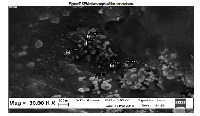Targeted drug delivery system- Formulation and evaluation of chitosan nanospheres containing Doxorubicin hydrochloride
Keywords:
chitosan, naoparticles, doxorubicin, cytotoxicity, targetingAbstract
A chitosan molecule form self-assembled nanoparticles that can encapsulate a quantity of drugs and deliver them to a specific site. Chemical attachment of drug to chitosan throughout the functional linker has possibility to produce useful prodrugs, exhibiting biological activity at target site. In vivo residence time of the dosage form in the gastrointestinal tract and bioavailability of various drugs increases by mucoadhesive and absorption enhancement properties of chitosan. Antitumour activity of doxorubicin(DOX)-incorporated nanoparticles in vitro on DOX- resistant C6 glioma cells. Nanoparticles showed increased cytotoxicity compared to DOX alone. These results suggest that doxorubicin (DOX) was unable to penetrate into cells and did not effectively inhibit cell proliferation. In contrast, nanoparticles can penetrate into cells and effectively inhibit cell proliferation. There are 3 batches of drug loaded nanospheres in which 2.5mg,5mg and 10mg of DOX were loaded into nanospheres where the concentration of chitosan is 1%w/v. Anticancer drugs without targeting a specific site cause side effects. The objective of this research is to reduce side effects. HPLC device was used to quantitatively analyze amount of doxorubicin loaded in nanospheres. The result had showed concentration of anticancer drug loaded in nanospheres is directly proportional to the drug payload capacity until saturation point. The in vitro drug release studies was carried out for 48 hours to obtain a more precise result by carrying out this studies in a medium resembling our body environment such as pH7.4, 37ÀC with analytical grade water for this studies. In vitro release of doxorubicin is of zero order kinetic. This shows that release is independent of the concentration of drug loaded in the nanospheres. Besides that, the graphs also show a sustained release manner, indicating these nanospheres formulation are suitable for targeting drug delivery system and for efficient treatment of cancerous cells.
References
. Drugs.com. Rubex® (doxorubicin
hydrochloride for injection, USP).
. Qin Tian et al. Glycyrrhetinic acidmodified chitosan/poly(ethylene
glycol) nanoparticles for liver-targeted
delivery. Biomaterials 31.2010; 4748-
. Gupta Manish and Sharma Vimukta.
Targeted drug delivery system: A
Review; Research Journal of
Chemical Sciences, 2011; 1 (2):135-
. Otilia M. Koo, Israel Rubinstein, Hayat
Onyuksei. Role of nanotechnology in
targeted drug delivery and imaging: a
concise review. Nanomedicine:
Nanotechnology, Biology and
Medicine, 2005;1(3): 193-212.
. VJ Mohanraj and Y Chen:
Nanoparticles- A Review. Tropical
Journal of Pharmaceutical Research,
; 5 (1): 561-573.
. Wim H De Jong and Paul JA Borm.
Drug delivery and nanoparticles:
Applications and hazards Int J
Nanomedicine. 2008; 3(2): 133ă149.
. Riddhi Dave and Rakesh Patel.
Preparation and characterization of
doxorubicin HCl loaded chitosan
nanoparticles by w/o emulsion
method. Int. J. of Pharm. & Life
Sci.2013; 4( 2): 2407-2413.
. Komal Patel et al. Preparation and in
vivo study of Doxorubicin HCl loaded
chitosan nanoparticles prepared by
w/o emulsion method. International
Journal of Current Research. 2012;
(12): 438-440.
. Parichart Naruphontjirakul et al.
Development of Doxorubicin - Core
Shell Chitosan Nanoparticles to Treat
Cancer. 2011;11:18-40





